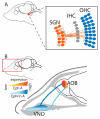Interactions between Guidance Cues and Neuronal Activity: Therapeutic Insights from Mouse Models
- PMID: 37108129
- PMCID: PMC10138948
- DOI: 10.3390/ijms24086966
Interactions between Guidance Cues and Neuronal Activity: Therapeutic Insights from Mouse Models
Abstract
Topographic mapping of neural circuits is fundamental in shaping the structural and functional organization of brain regions. This developmentally important process is crucial not only for the representation of different sensory inputs but also for their integration. Disruption of topographic organization has been associated with several neurodevelopmental disorders. The aim of this review is to highlight the mechanisms involved in creating and refining such well-defined maps in the brain with a focus on the Eph and ephrin families of axon guidance cues. We first describe the transgenic models where ephrin-A expression has been manipulated to understand the role of these guidance cues in defining topography in various sensory systems. We further describe the behavioral consequences of lacking ephrin-A guidance cues in these animal models. These studies have given us unexpected insight into how neuronal activity is equally important in refining neural circuits in different brain regions. We conclude the review by discussing studies that have used treatments such as repetitive transcranial magnetic stimulation (rTMS) to manipulate activity in the brain to compensate for the lack of guidance cues in ephrin-knockout animal models. We describe how rTMS could have therapeutic relevance in neurodevelopmental disorders with disrupted brain organization.
Keywords: ephrin; neuronal activity; neuroplasticity; rTMS; sensory systems; topography.
Conflict of interest statement
The authors declare no conflict of interest.
Figures



Similar articles
-
Ephrin-As are required for the topographic mapping but not laminar choice of physiologically distinct RGC types.Dev Neurobiol. 2015 Jun;75(6):584-93. doi: 10.1002/dneu.22265. Epub 2015 Feb 18. Dev Neurobiol. 2015. PMID: 25649160 Free PMC article.
-
Balancing of ephrin/Eph forward and reverse signaling as the driving force of adaptive topographic mapping.Development. 2012 Jan;139(2):335-45. doi: 10.1242/dev.070474. Epub 2011 Dec 7. Development. 2012. PMID: 22159582
-
Ephrins and Ephs in cochlear innervation and implications for advancing cochlear implant function.Laryngoscope. 2015 May;125(5):1189-97. doi: 10.1002/lary.25066. Epub 2014 Dec 23. Laryngoscope. 2015. PMID: 25533791
-
Connecting thalamus and cortex: the role of ephrins.Anat Rec A Discov Mol Cell Evol Biol. 2006 Feb;288(2):135-42. doi: 10.1002/ar.a.20286. Anat Rec A Discov Mol Cell Evol Biol. 2006. PMID: 16411249 Review.
-
Developmental mechanisms of topographic map formation and alignment.Annu Rev Neurosci. 2013 Jul 8;36:51-77. doi: 10.1146/annurev-neuro-062012-170341. Epub 2013 Apr 29. Annu Rev Neurosci. 2013. PMID: 23642132 Review.
References
Publication types
MeSH terms
Substances
Grants and funding
LinkOut - more resources
Full Text Sources
Miscellaneous

